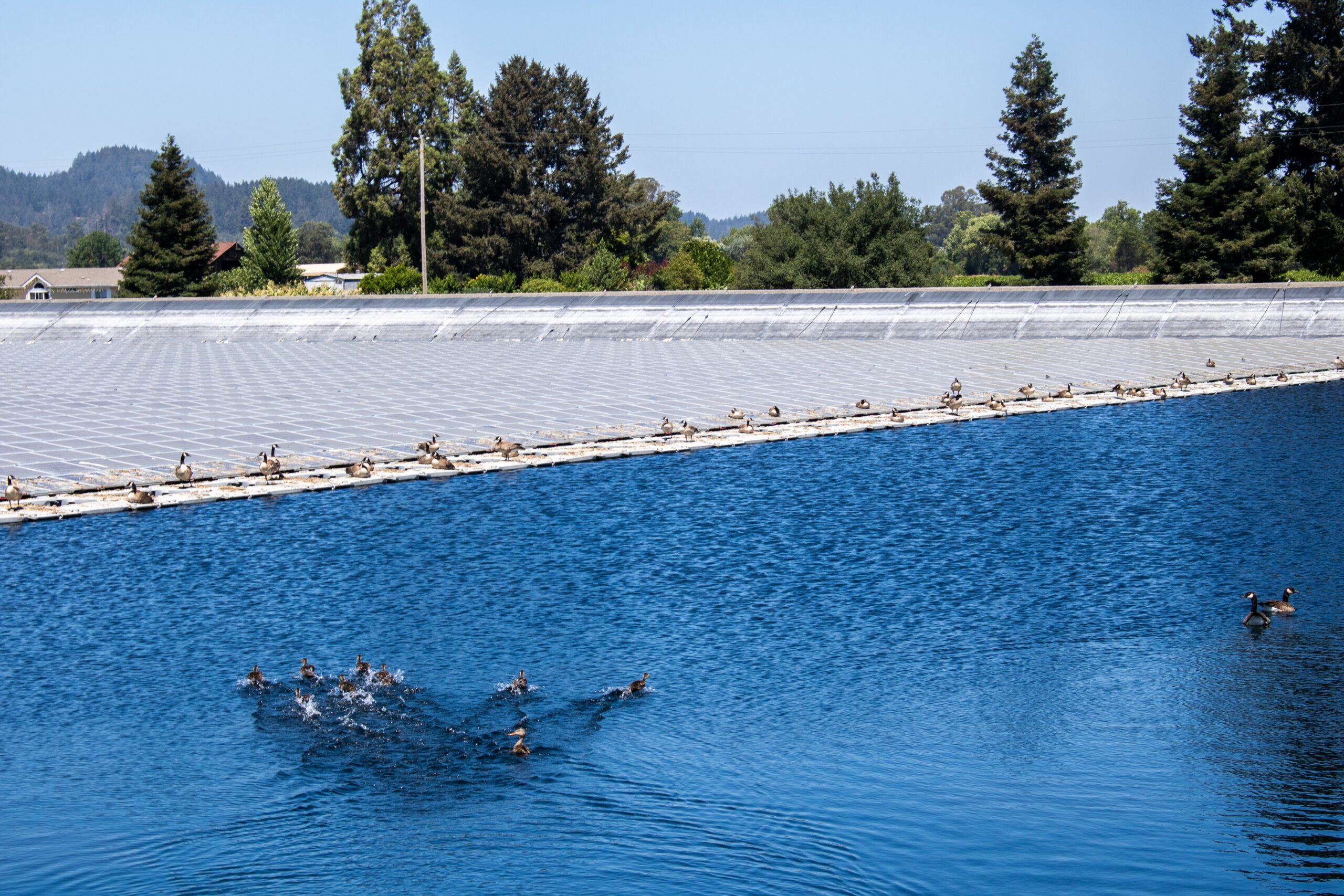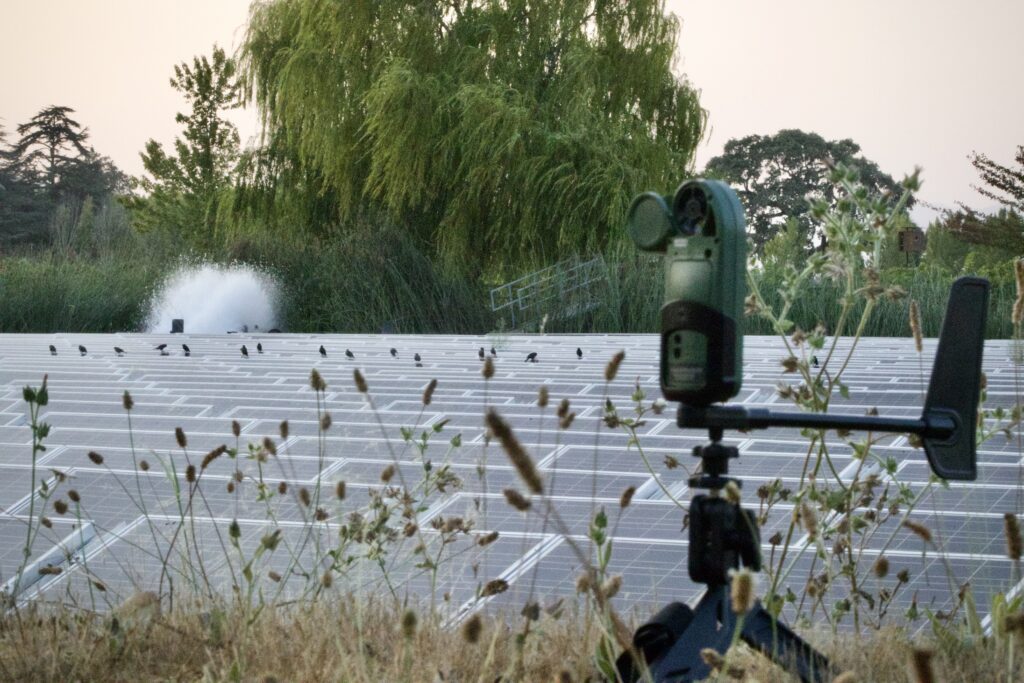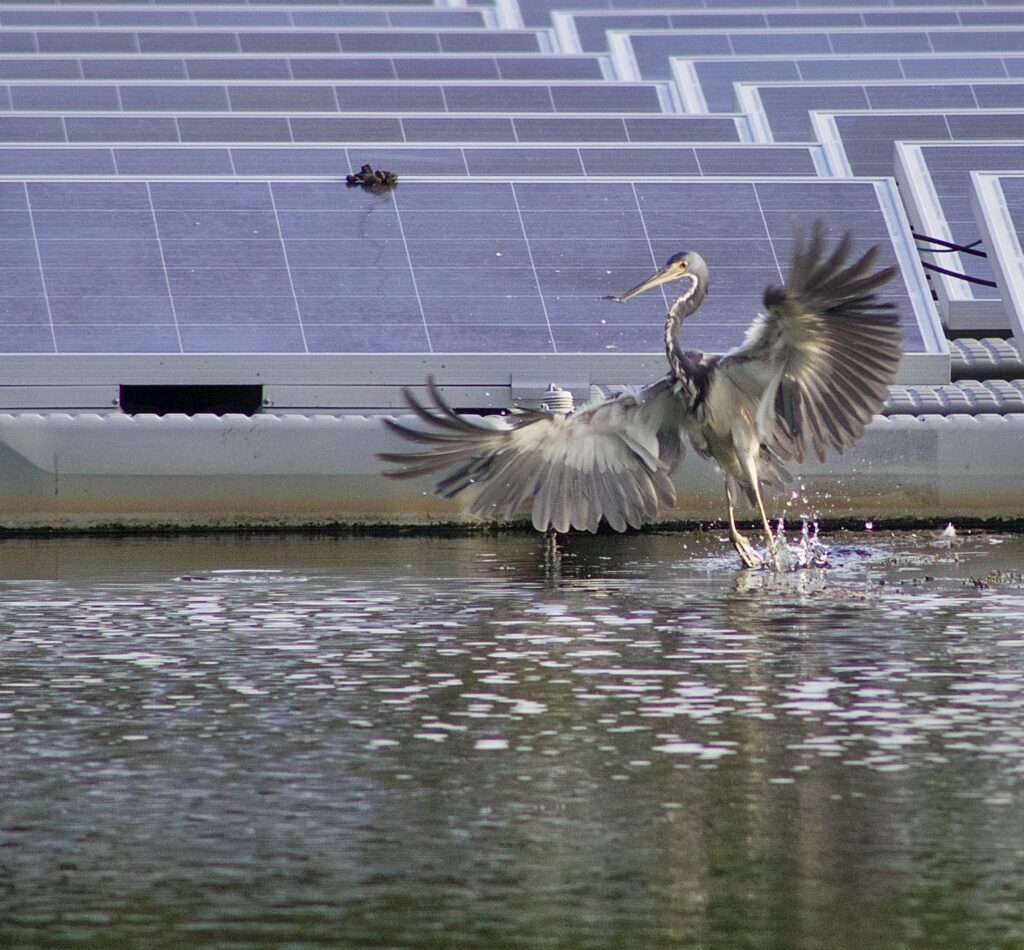
In the late 2000s, small-aircraft pilots gliding above the Napa countryside began to notice an odd, glassy glint reflecting off a tennis-court-size patch of land between vineyards. Large solar arrays were less common back then, but the solar panels themselves likely weren’t the reason planes doubled back, flying low, for a closer look: it was their placement in the middle of a pond.
Floating solar panels, like the ones Napa’s Far Niente winery finished installing in 2009, could be a real windfall for a watery Bay-Delta region seeking carbon-free energy. Secured to buoyant platforms or pontoons, low over the water’s surface and at a slight angle, the panels can cover a large area without competing with agriculture or housing for primo sun-drenched land. They slow evaporation from the water sources they cover that might otherwise dwindle to nothing in the summertime. And of course, they make electricity without emitting the planet-heating gases that are deepening droughts, worsening wildfires, and drowning coastlines in California.
With the technology gaining traction, it may not be long before floating solar panels are soaking up the sun atop bodies of water large and small throughout the Delta and San Francisco Estuary. But which sorts of places are best suited for this emerging approach to solar energy?
“It’s that old story of location, location, location,” says Rebecca Hernandez, an associate professor of ecology and earth sciences at UC Davis who studies interactions between energy infrastructure and ecosystems.

Drawing a parallel to land-based solar, she rattles off two examples of siting with vastly different ecological implications: building solar panels on the roof of a parking garage, or in a natural desert scrubland. It’s no hypothetical that California would develop large solar farms on the latter, despite an abundance of sunny parking-garage roofs going unused. Hernandez worries that floating solar could be destined for the same kind of clash in the coming years, and potentially impact vulnerable aquatic and avian species and ecosystems in the race to build renewable energy if siting decisions are not made carefully.
“Birds don’t know what [it] is,” she adds. “This is the first time in their evolutionary history that they’ve encountered this really weird, water-looking-like, but very hard material … on the pond that they used to swim across or fly across.” Capping a pond with sheets of gleaming silicon and glass could also impact its ecology by altering water temperature and circulation and affecting the local food web.
Floating solar proponents might point out that the same ecosystems and species that might be disrupted by floating solar arrays also face disruption from a warming and unchecked climate. Carbon-free energy like solar power is a key part of limiting that warming, and it’s hard to argue against building more of that energy, and fast.
Complicating the decision-making process about where floating solar should go is that California’s aquatic spaces, much like its lands, rarely exist in neat bins of “natural” or “human-made.” Constructed reservoirs can still support native species and offer cherished recreational opportunities to human communities, and even a more heavily managed site like a wastewater treatment pond can support wildlife. The small Sonoma County town of Healdsburg boasts the nation’s largest floating solar array on its treatment ponds, and Canadian geese there have staked the edge of the array nearest the open water as their own territory—marked by generous splatters of white excrement along those panels.
“They’re year-long residents, and before we put the solar in, they would hang out on this roadway,” says Healdsburg utility director Terry Crowley. “So we’re actually kind of happier that they’re on that part of it.”
Elsewhere, Hernandez says her team has observed some astonishing, even delightful, interactions between wildlife and floating panels. At a Florida research site, otters will play among the arrays while herons strategically hunt off the floats.

And Greg Allen, a Far Niente winemaker and the mastermind behind the winery’s first-in-the-world floating solar project, says he still hears frogs chorusing from the irrigation pond that has now been covered with solar panels for well over a decade.
There are still plenty of places floating solar can go that align with the analogue of a parking garage roof more than an undisturbed desert. California’s concrete-walled aqueduct system and many wastewater treatment and industrial cooling ponds could be places to start making power and saving water, with minimal disturbance to wildlife habitats.
If floating solar construction accelerates around the San Francisco Estuary, now may be the best and only moment to avoid repeating mistakes made, from an ecological perspective, in the rush to build large solar farms on land. A more cautious approach needn’t require stalling floating solar development. But it would likely prioritize areas with less consequential habitat first, by learning where the watery equivalents of “parking garages” are and starting with setting solar panels afloat there. In the meantime, scientists can learn more about whether, and where, more sensitive watery habitats and floating solar can best coexist in peace.
“There is no data out there right now,” warns Hernandez. “We are taking a picture of this moving train as it speeds past us.”
LINKS
Bay Area Leads Nation On Floating Solar (KneeDeep Times)
Drone footage of Healdsburg floating array
City of Healdsburg live graph of floating array power production
Study of Ecological Risks as Solar Expands
Top photo: A mallard and her ducklings join the geese at the city of Healdsburg’s wastewater treatment plant power ponds. Photo: Sierra Garcia